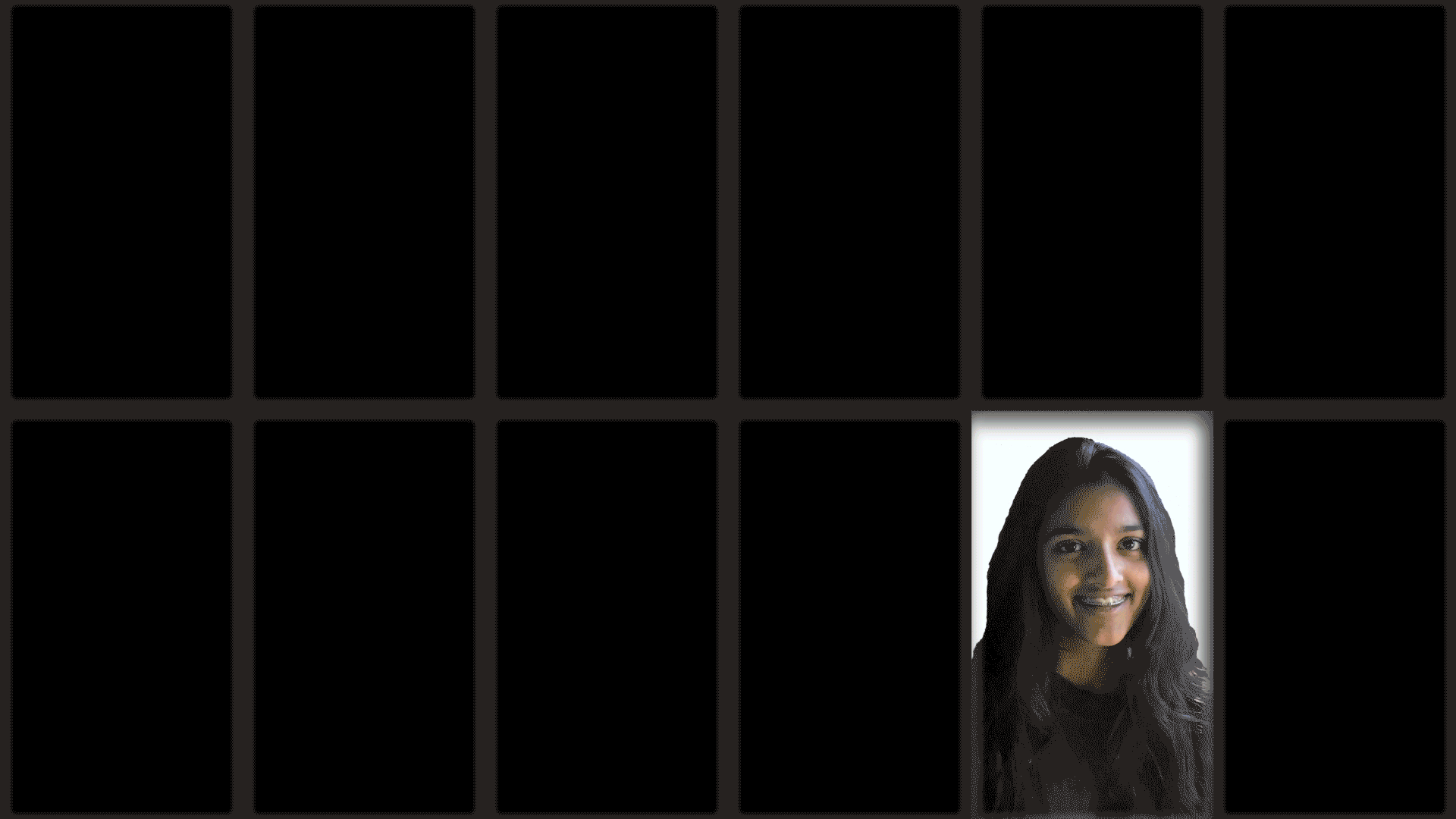By Bill Cheng, Gauri Kaushik and Ilena Peng
T he car’s tires screeched to a halt only centimeters away from senior Sarah Harb. She had just stepped onto the crosswalk when she noticed that a car had accelerated towards her instead of slowing down. She could only stare in disbelief at the driver — given the timing, she attributed the anger in his eyes to Harb’s hijab. It was the day after the 2015 Paris terror attacks.
“I remember hearing a bunch of screams from the other side of street, like on the sidewalk and they were like ‘Oh my gosh, are you crazy?’ to the [driver,]” Harb said. “He kind of just looked at me and I just looked at him, and I was so shocked. I had no idea what to say. And then I just ran across the street.”
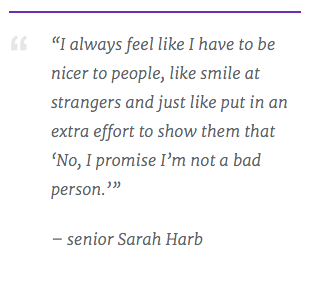
Harb is Muslim, and her hijab is a proud part of her identity. Yet, she’s also watched the media and certain political groups connect that identity to the word “terrorism.” It’s made her more aware of what her presence in that overarching way of life — “Muslim” — means, even though she has never considered agreeing with the extremist sentiments that Trump and the media refers to.
“When the elections started, I was like ‘Oh, now it’s awkward. Now everyone pays attention to me…'" Harb said. “I always feel like I have to be nicer to people, like smile at strangers and just like put in an extra effort to show them that ‘No, I promise I’m not a bad person.’”
Growing up, junior Benjamin Bedregal also felt the same pressure to appear nicer to compensate for a negative reputation because of his Hispanic ethnicity.
“My mom, she always tells me ‘Oh, you have to keep a clean image, because you are already looked down upon as it is,’” Bedregal said. “I have definitely become more conscious of my decisions.”
Like Bedregal, freshman Dhruvika Randad, has always been aware of both her race and her identity. She moved here when she was five months old, though she only recently acquired citizenship. If anywhere, she says, the U.S. is her home. Due to the current political climate, that awareness has been heightened, but to her, that awareness doesn’t validate others who try to make assumptions due to her identity.
“Yes, I am a brown girl but you cannot just point that out,” Randad said. “You're aware of that, I’m aware of that, but what statement are you trying to make saying that? Is it going to change something? I’m not going to automatically become someone else.”
Melissa Michelson, a political science professor at Menlo College who studies minority integration, drew parallels to this Martin Niemoller quote as she described the way that minorities have come together over the past year. Niemoller, a German Protestant pastor, presented this quote after World War II to represent a plea for support among communities during the Holocaust. Seventy years later, Michelson sees a reflection of that plea being answered as she watches communities unite of their own accord.
“I think marginalized communities [and] minority communities have learned the lesson of strength in numbers [and] in coming together,” Michelson said. “[They] have taken to heart the idea that ‘they might not be after us this time, but it could be us next time and we all have to stand together against hate.’”
In describing pride parades, sophomore Shravanti Shankar recognizes the renewed energy towards standing together as a community. Shankar is pansexual, meaning that her sexual choice is not limited to people of a specific gender identity or sexual orientation. Although she says that members of the LGBTQ+ community have always been supportive of each other, the current political climate has drawn more attention to the necessity of that support.
“The community is very good at sticking together and that was put into place long before the election,” Shankar said. “But I also do know that, maybe it’s a little more, we feel the need to stick together more because of the political stance of the country now.”
Bedregal has seen different minorities come together over the past year, uniting as one voice. But he’s quick to point out that there’s a difference between coming together as a community and appearing like a group of nationalists.
“I don’t want to say [it’s] boosted nationalism, that’s not the right word — but it’s kind of made me feel like a part of something, because everybody is speaking out and coming together,” Bedregal said.
Junior Ananya Saxena echoed Bedregal’s sentiment that the groups Trump has been antagonistic towards, such as female activists like Saxena herself, have been able to unite more easily. However, she also noted how the events that followed the election could serve to further the distance between groups.
“There [is] a strong community of people and more and more girls and guys are identifying as feminists,” Saxena said. “But it also causes a huge separation between people who don’t necessarily think that like feminism is their ‘thing’ or even just people who genuinely support Trump — it causes all sorts of divides."
According to Michelson, perhaps the best response to a hateful event is coming together to support each other in a way they might not have done before, since the natural way people divide themselves into distinctive communities can make discrimination a somewhat internal issue.
“We naturally want to divide ourselves up into groups as a way of establishing our own identity,” Michelson said. “And to change human nature and to get people to not want to sort themselves into identity groups, I think is probably impossible.”

Michelson sees law enforcement and social norms as a necessity to suppress those acting out on their racist beliefs. But she also suggests that the problem is the actions of Trump’s administration, such as Trump’s Muslim Ban (formally referred to as “Protecting the nation from Foreign Terrorist Entry into the U.S.”). Specific incidents like Trump’s lag in incriminating the violence in Charlottesville leads Michelson to believe Trump condones those racist thoughts.
Yet a senior points out that it’s important to note that being Republican doesn’t necessarily signify a correlation with racist or white extremist views. He requested anonymity due to his concern that his conservative political views would negatively impact his college recommendation letters from more liberal teachers and for the purpose of this story, we will refer to him as Kurt. Just as Harb refers to the fact that the majority of Muslims aren’t terrorists, Kurt states that the majority of Republicans aren’t white extremists.
“The Trump administration has kind of demonized a lot of Republicans,” Kurt said.
Personally, Kurt varies in support of Trump’s policies. He supports the idea of preventing illegal immigration, as he believes it makes it harder for those who are trying to legally immigrate. Yet he opposed the travel ban, believing that Trump is being rather difficult on those who are coming here legally.
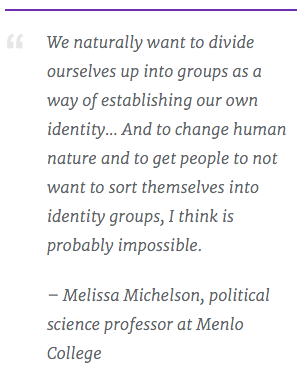
For the most part, he says that he is more economically conservative than socially. Republicans like Kurt aren’t opposed to immigrants or the LGBTQ+ community, but as Michelson mentioned earlier, the actions of the Trump administration have still given those minority groups a reason to worry.
Although that worry hasn’t necessarily led to the formation of connections between different identity groups in the eyes of senior Ben Pribe, he believes the way people have become more outspoken about their beliefs since the election has made their political views seem more black and white. It’s more apparent where people stand, according to Pribe, and he believes that the more apparent stances could lead to a stronger bond between communities.
“[It] causes some communities to become tighter because their political ideals are closer but I’m not sure if it's to support each other,” Pribe said. “Maybe it’s just to surround yourself with people who agree with you because it's certainly made it more clear — it's more of an ‘us or them’ kind of thing than it was before. There's a certain amount of picking sides that was maybe a little less apparent before.”
According to Michelson, hate groups and neo-Nazi groups have existed underground for a long time, but the current political climate has since brought them into the public view. Michelson points out the difficulty of identifying whether beliefs have changed, but believes that the expression of those beliefs have become more acceptable during the past year. And to Michelson, it’s also naive to believe that those sentiments don’t exist in the Bay Area.
“Those anti-democratic, white nationalists, homophobic, islamophobic thoughts are here too,” Michelson said. “And while some people like to think we're in a bubble, they might want to look around a little bit more carefully because that stuff's happening here too. And [the]Trump administration is helping those folks feel emboldened to act out their belief.”
Bedregal has noticed the way the extremist groups have put themselves into the public eye, and the new awareness of those groups has made Bedregal more internally conscious of his decisions, although it doesn’t affect his daily behavior.
“Due to Trump becoming president I feel like it kind of acted as a blanket for more people with more racist views — they felt more safe to express their views with the current president, and that kind of led to an increased amount of racist political views,” Bedregal said.
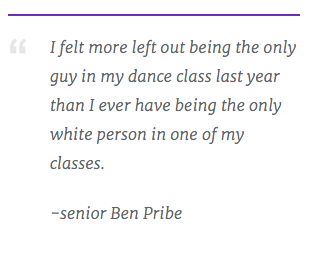
Although Kurt does not entirely align with Trump’s views, he describes his political beliefs as both Libertarian and Republican, leaning more towards the latter. Despite knowing that conservative views are present in the Bay Area, he’s found that they are still uncommon — particularly among students. Of the people he knows, few are Republican. And of those, even fewer are his age.
“This area is definitely very liberal, which is kind of unfortunate,” Kurt said. “I'd like to see a lot more other views being shared around.”
Most of his friends know that he is Republican, and his best friend is Republican too. The last day of their sophomore year, the two of them attended a Trump rally. But in an area that still feels largely liberal, he’s found that during political conversations or when some of his teachers express more liberal opinions, it’s best to stay quiet.
“Oftentimes, I just won't mention anything,” Kurt said. “[It’s] just not worth it sometimes.”
Kurt doesn’t share his political views on occasion due to the liberal perspectives surrounding him, and similarly, Shankar doesn’t divulge her sexuality when she’s around more conservative family friends. She’s noticed the same thing that Kurt has — that there are more conservative parents than students.
“I have a lot of Indian family friends who have more conservative backgrounds, so I’m not really out to my parents’ friends,” Shankar said. “Cupertino is more liberal, but it also has a lot of … like the parents are usually the ones I’m more concerned about than the kids.”
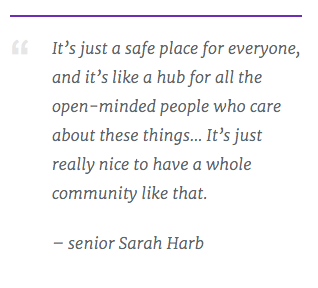
Harb says the occasional judgmental look from people at school reveals the obvious fact that not everyone here is entirely accepting. Other times, she’s felt people are hesitant and look more uncomfortable when talking to her for the first time. But the more liberal demographic of Cupertino does offer a feeling of safety for some — Harb says she still feels safer here than she would in other places in the nation.
“It’s just a safe place for everyone, and it’s like a hub for all the open-minded people who care about these things,” Harb said. “It’s just really nice to have a whole community like that.”
This community is also one that’s unique among the nation in that typically minority communities make up the majority of citizens — 83 percent of MVHS is Asian, and 51 percent of Cupertino’s population was born outside of the U.S. Pribe has found that here, his caucasian identity makes him a minority. But he still feels comfortable in Cupertino and said he’s never felt as if he was being treated differently.
“I felt more left out being the only guy in my dance class last year than I ever have being the only white person in one of my classes,” Pribe said.
Saxena also commented on how she feels more comfortable in California, and the Bay Area specifically, compared to the rest of the nation, citing her discomfort when she visited Virginia right after the election. She felt out of place with ‘America’ stores surrounding her and people openly supporting Trump, a stark contrast to Santa Clara County, where 44.8% of registered voters are Democratic, in comparison with the 25.9% of registered Republicans, according to the Public Policy Institute of California.
“[It’s one of the] big Trump-supporting states and I just felt uncomfortable because they all have all this ‘patriotism’ but I don’t think it’s directed at something that’s going to make the country better,” Saxena said.
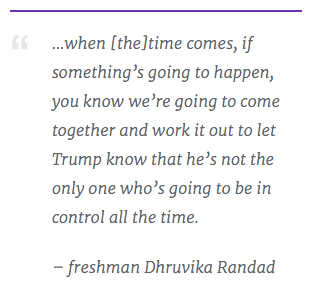
Randad believes it’s hard to pinpoint the best way to make the country better. She believes the unpredictable aftermath protests have makes them less effective. In the meantime, she finds taking strength in identity to be the best form of maintaining hope and resistance.
“You are who you are,” Randad said. “Don't let anyone change that. And despite all the things that [have] happened, we have to do our best to take it on and just work with it. And when [the] time comes, if something’s going to happen, you know we’re going to come together and work it out to let Trump know that he’s not the only one who’s going to be in control all the time.”
Regardless of the way communities seem to have rallied together, Michelson and Harb can’t predict the impact of the current political climate. Michelson doesn’t believe the Trump administration has brought us closer to equality. But she also points out that President Obama’s election didn’t end racism. The longstanding problem is one that is complicated to solve, and she thinks perhaps time will be the answer. Harb agrees.
After spending several summers in Lebanon, Harb has noticed that the country thrives as a melting pot of different religions and cultures that’s not all that different from the one in Cupertino. Although she said that there was never a moment in Lebanon’s history that resembles the U.S.’s current state of ideological turmoil, she still believes that time may push the U.S. in a more peaceful direction.
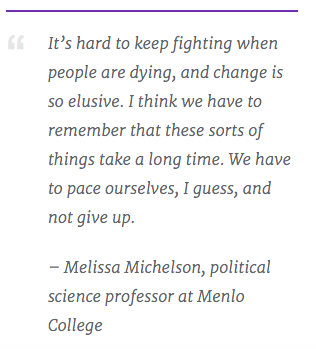
“They know more about each other's religions,” Harb said. “They’ve accepted that [diversity] and they’ve been living like that for so long — for centuries and obviously, America’s younger than that… I feel like we haven’t had enough time to accept [that diversity.]”
Michelson offers a reminder that change has always been slow. She points out how it took two years for the Watergate investigation to lead to President Nixon’s resignation. It took the Civil Rights Movement decades to make progress. Michelson points out that technology has misled us to see the world move at an incredibly fast pace, yet social change still comes slowly.
“It’s hard to keep up your momentum when you feel like you're not making any progress and the movement’s not working,” Michelson said. “It’s hard to keep fighting when people are dying, and change is so elusive. I think we have to remember that these sorts of things take a long time. We have to pace ourselves, I guess, and not give up.”
